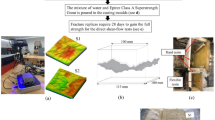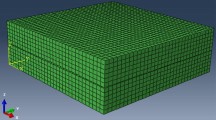Abstract
The flow of a single-phase fluid through a rough-walled rock fracture is discussed within the context of fluid mechanics. The derivation of the ‘cubic law’ is given as the solution to the Navier-Stokes equations for flow between smooth, parallel plates - the only fracture geometry that is amenable to exact treatment. The various geometric and kinematic conditions that are necessary in order for the Navier-Stokes equations to be replaced by the more tractable lubrication or Hele-Shaw equations are studied and quantified. In general, this requires a sufficiently low flow rate, and some restrictions on the spatial rate of change of the aperture profile. Various analytical and numerical results are reviewed pertaining to the problem of relating the effective hydraulic aperture to the statistics of the aperture distribution. These studies all lead to the conclusion that the effective hydraulic aperture is less than the mean aperture, by a factor that depends on the ratio of the mean value of the aperture to its standard deviation. The tortuosity effect caused by regions where the rock walls are in contact with each other is studied using the Hele-Shaw equations, leading to a simple correction factor that depends on the area fraction occupied by the contact regions. Finally, the predicted hydraulic apertures are compared to measured values for eight data sets from the literature for which aperture and conductivity data were available on the same fracture. It is found that reasonably accurate predictions of hydraulic conductivity can be made based solely on the first two moments of the aperture distribution function, and the proportion of contact area.
Similar content being viewed by others
References
Aitchison, J. and Brown, J. A. C.: 1957, The Lognormal Distribution, Cambridge University Press, New York.
Amadei, B. and Illangasekare, T.: 1992, Analytical solutions for steady and transient flow in nonhomogeneous and anisotropic rock joints, Int. J. Rock Mech. 29, 561–572.
Batchelor, G. K.: 1967, An Introduction to Fluid Dynamics, Cambridge University Press, New York.
Bear, J.: 1972, Dynamics of Fluids in Porous Media, Elsevier, New York.
Bear, J., Tsang, C.-F. and de Marsily, G.: 1993, Flow and Contaminant Transport in Fractured Rock, Academic Press, San Diego, California.
Beran, M. J.: 1968, Statistical Continuum Theories, Interscience, New York.
Bers, L., John, F. and Schechter, M.: 1964, Partial Differential Equations, Wiley-Interscience, New York.
Brown, S. R.: 1987, Fluid flow through rock joints: the effect of surface roughness, J. Geophys. Res. 92, 1337–1347.
Brown, S. R.: 1989, Transport of fluid and electric current through a single fracture, J. Geophys. Res. 94, 9429–9438.
Brown, S. R. and Scholz, C. H.: 1985, Broad bandwidth study of the topography of natural rock surfaces, J. Geophys. Res. 90, 12575–12582.
Brown, S. R., Kranz, R. L. and Bonner, B. P.: 1986, Correlation between the surfaces of natural rock joints, Geophys. Res. Lett. 13, 1430–1433.
Carslaw, H. S. and Jaeger, J. C.: 1959, Conduction of Heat in Solids, Oxford University Press, Oxford.
Coulaud, O., Morel, P. and Caltagirone, J. P.: 1991, Numerical modeling of nonlinear effects in laminar flow through a porous medium, J. Fluid Mech. 190, 393–407.
Dagan, G.: 1979, Models of groundwater flow in statistically homogeneous porous formations, Water Resour. Res. 15, 47–63.
Dagan, G.: 1993, Higher-order correction of effective permeability of heterogeneous isotropic formations of lognormal conductivity distribution, Transport in Porous Media 12, 279–290.
de Marsily, G.: 1986, Quantitative Hydrogeology, Academic Press, San Diego, California.
Elrod, H. G.: 1979, A general theory for laminar lubrication with Reynolds roughness, J. Lubr. Technol. 101, 8–14.
Gale, J., MacLeod, R. and LeMessurier, P.: 1990, Site characterization and validation - Measurement of flowrate, solute velocities and aperture variation in natural fractures as a function of normal and shear stress, stage 3, Stripa Project Report 90–11, Swedish Nuclear Fuel and Waste Management Company, Stockholm.
Geertsma, J.: 1974, Estimating the coefficient of inertial resistance in fluid flow through porous media, Soc. Petrol. Eng. J. 14, 445–450.
Gentier, S., Billaux, D. and van Vliet, L.: 1989, Laboratory testing of the voids of a fracture, Rock Mech. Rock Eng. 22, 149–157.
Grant, M. A., Donaldson, I. G. and Bixley, P. F.: 1982, Geothermal Reservoir Engineering, Academic Press, New York.
Gutjahr, A. L., Gelhar, L. W., Bakr, A. A. and MacMillan, J. R.: 1978, Stochastic analysis of spatial variability in subsurface flows 2. Evaluation and application, Water Resour. Res. 14, 953–959.
Hakami, E.: 1989, Water flow in single rock joints, Licentiate thesis, Lulea University of Technology, Lulea, Sweden.
Hakami, E. and Barton, N.: 1990, Aperture measurements and flow experiments using transparent replicas of rock joints, in N. Barton and O. Stephansson (eds), Rock Joints: Proceedings of the International Symposium on Rock Joints, Balkema, Rotterdam, pp. 383–390.
Hasegawa, E. and Izuchi, H.: 1983, On steady flow through a channel consisting of an uneven wall and a plane wall, Part 1, Case of no relative motion in two walls, Bull. Jap. Soc. Mech. Eng. 26, 514–520.
Hashin, Z.: 1983, Analysis of composite materials - A survey, J. Appl. Mech. 50, 481–505.
Hashin, Z. and Shtrikman, S.: 1962, A variational approach to the theory of the effective magnetic permeability of multiphase materials, J. Appl. Phys. 33, 3125–3131.
Holditch, S. A. and Morse, R. A.: 1976, The effects of non-Darcy flow on the behavior of hydraulically fractured gas wells, J. Petrol. Technol. 28, 1169–1179.
Johns, R. A., Steude, J. S., Castanier, L. M. and Roberts, P. V.: 1993, Nondestructive measurements of fracture aperture in crystalline rock cores using X-ray computed tomography, J. Geophys. Res. 98, 1889–1900.
Jung, R.: 1989, Hydraulic in situ investigations of an artificial fracture in the Falkenberg granite, Int. J. Rock. Mech. 26, 301–308.
Kirkpatrick, S.: 1973, Percolation and conduction, Rev. Mod. Phys. 45, 574–588.
Kumar, S., Zimmerman, R. W. and Bodvarsson, G. S.: 1991, Permeability of a fracture with cylindrical asperities, Fluid Dyn. Res. 7, 131–137.
Landau, L. D. and Lifshitz, E. M.: 1960, Electrodynamics of Continuous Media, Pergamon Press, New York.
Lomize, G. M.: 1951, Filtratsiia v Treshehinovatykh Porod (Water Flow in Jointed Rock), Gosenergoizdat, Moscow.
Louis, C.: 1969, A study of groundwater flow in jointed rock and its influence on the stability of rock masses, Ph.D. dissertation, Imperial College, London.
Maxwell, J. C.: 1873, A Treatise on Electricity and Magnetism, Clarendon Press, Oxford.
Nelson, R. A.: 1985, Geologic Analysis of Naturally Fractured Reservoirs, Gulf Publishing, Houston.
Neuzil, C. E. and Tracy, J. V.: 1981, Flow through fractures, Water Resour. Res. 17, 191–199.
Obdam, A. N. M. and Veling, E. J. M.: 1987, Elliptical inhomogeneities in groundwater flow - an analytical description, J. Hydrol. 95, 87–96.
Patir, N. and Cheng, H. S.: 1978, An average flow model for determining effects of three-dimensional roughness on partial hydrodynamic lubrication, J. Lubr. Technol. 100, 12–17.
Phillips, O. M.: 1991, Flow and Reaction in Permeable Rocks, Cambridge University Press, New York.
Piggott, A. R. and Elsworth, D.: 1992, Analytical models for flow through obstructed domains, J. Geophys. Res. 97, 2085–2093.
Piggott, A. R. and Elsworth, D.: 1993, Laboratory assessment of the equivalent apertures of a rock fracture, Geophys. Res. Lett. 20, 1387–1390.
Pozrikidis, C.: 1987, Creeping flow in two-dimensional channels, J. Fluid Mech. 180, 495–514.
Pruess, K., Wang, J. S. Y. and Tsang, Y. W.: 1990, On thermohydrologic conditions near high-level nuclear wastes emplaced in partially saturated fractured tuff, 1, Simulation studies with explicit consideration of fracture effects, Water Resour. Res. 26, 1235–1248.
Pyrak-Nolte, L. J., Myer, L. R., Cook, N. G. W. and Witherspoon, P. A.: 1987, Hydraulic and mechanical properties of natural fractures in low permeability rock, in G. Herget and S. Vongpaisal (eds), Proceedings of the 6th International Congress of Rock Mechanics, Balkema, Rotterdam, pp. 225–231.
Reynolds, O.: 1886, On the theory of lubrication, Phil. Trans. Roy. Soc. London 177, 157–134.
Sangani, A. S. and Yao, C.: 1988, Transport processes in random arrays of cylinders. II. Viscous flow, Phys. Fluids 31, 2435–2444.
Schlichting, H.: 1968, Boundary-Layer Theory, 6th edn., McGraw-Hill, New York.
Sherman, F.: 1990, Viscous Flow, McGraw-Hill, New York.
Silliman, S. E.: 1989, An interpretation of the difference between aperture estimates derived from hydraulic and tracer tests in a single fracture, Water Resour. Res. 25, 2275–2283.
Stokes, G. G.: 1905, Mathematical and Physical Papers, Cambridge University Press, Cambridge.
Thompson, B. W.: 1968, Secondary flow in a Hele-Shaw cell, J. Fluid Mech. 31, 379–395.
Tsang, Y. W. and Witherspoon, P. A.: 1981, Hydromechanical behavior of a deformable rock fracture subject to normal stress, J. Geophys. Res. 86, 9287–9298.
Tsay, R.-Y. and Weinbaum, S.: 1991, Viscous flow in a channel with periodic cross-bridging fibers: exact solutions and Brinkman approximation, J. Fluid Mech. 226, 125–148.
van Golf-Racht, T. D.: 1982, Fundamentals of Fractured Reservoir Engineering, Elsevier, Amsterdam.
Walsh, J. B.: 1981, The effect of pore pressure and confining pressure on fracture permeability, Int. J. Rock Mech. 18, 429–435.
Wang, J. S. Y., Narasimhan, T. N. and Scholz, C. H.: 1988, Aperture correlation of a fractal fracture, J. Geophys. Res. 93, 2216–2224.
Warren, J. E. and Price, H. S.: 1960, Flow in heterogeneous porous media, Soc. Petrol. Eng. J. 1, 153–169.
Witherspoon, P. A., Wang, J. S. Y., Iwai, K. and Gale, J. E.: 1980, Validity of cubic law for fluid flow in a deformable rock fracture, Water Resour. Res. 16, 1016–1024.
Wright, D. E.: 1968, Nonlinear flow through granular media, Proc. Amer. Soc. Civ. Eng. Hydr. Div. 94, 851–872.
Zimmerman, R. W. and Kumar, S.: 1991, A fluid-mechanical model for blood flow in lung alveoli, in J. J. McGrath (ed), Advances in Biological Heat and Mass Transfer, ASME Heat Transfer Division Vol. 189, American Society of Mechanical Engineers, New York, pp. 51–56.
Zimmerman, R. W., Chen, D. W. and Cook, N. G. W.: 1992, The effect of contact area on the permeability of fractures, J. Hydrol. 139, 79–96.
Zimmerman, R. W., Kumar, S. and Bodvarsson, G. S.: 1991, Lubrication theory analysis of the permeability of rough-walled fractures, Int. J. Rock Mech. 28, 325–331.
Author information
Authors and Affiliations
Rights and permissions
About this article
Cite this article
Zimmerman, R.W., Bodvarsson, G.S. Hydraulic conductivity of rock fractures. Transp Porous Med 23, 1–30 (1996). https://doi.org/10.1007/BF00145263
Received:
Revised:
Issue Date:
DOI: https://doi.org/10.1007/BF00145263




